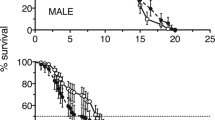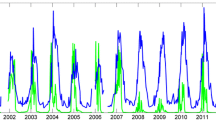Summary
The rate of oxygen consumption in all developmental stages of two benthic cyclopoid copepod species, Acanthocyclops viridis (Jurine) and Eucyclops agilis (Koch, Sars) was investigated at temperatures between 5° C–20° C, which are reflective of the environmental temperature range of the benthic zone in Esthwaite Water, Cumbria, from which the organisms were derived. The larger species, A. viridis was found to have a temperature insensitive metabolism, whereas E. agilis showed a marked temperature response in respiratory function. Gravid and non-gravid females had similar rates of respiration except at 15° C–20° C in E. agilis. Males exhibited much lower respiration rates than females, but higher weight specific respiration rates; these differences were largely attributable to size differentials between the sexes. Estimates of swimming activity were made and these were related to the patterns of respiratory function observed.
Similar content being viewed by others
References
Brandl Z, Fernando CH (1975) Food consumption and utilization in two freshwater cyclopoid copepods (Mesocyclops edax and Cyclops vicinus). Int Revue ges Hydrobiol 60:471–494
Coker RE (1933) Influence of temperature on size of freshwater copepods. Int Revue ges Hydrobiol 29:406–436
Comita GW (1965) Oxygen consumption in Diaptomus siciloides Lilljeborg. Limnol Oceangr 10:466–468
Conover RJ (1959) Regional and seasonal variation in the respiratory rate of marine copepods. Limnol Oceangr 4:259–268
Coull BC, Vernberg WB (1970) Harpacticoid copepod respiration: Enhydrosoma propinquum and Longipedia helgolandica. Marine Biology 5:341–344
Epp RW, Lewis WM (1979) Sexual dimorphism in Brachinus plicatilis (Rotifera): its evolutionary and adaptive significance. Evolution 33:919–928
Epp RW, Lewis WM (1980) The nature and ecological significance of metabolic changes during the life history of copepods. Ecology 61:259–264
Epp RW, Lewis WM (1984) Cost and speed of locomotion for rotifers. Oecologia (Berlin) 61:289–292
Grainger JNR (1974) The effect of temperature on size and structure. I — Body size of Cyclops agilis (Koch, Sars). Proc Irish Acad 74B:53–61
Gyllenberg G (1973) Comparison of the cartesian diver technique and the polarographic method, an open system, for measuring the respiratory rates in three marine copepods. Com Biol Soc Sci Fen 60:3–13
Heinle DR (1969) Temperature and zooplankton. Chesapeake Science 10:186–209
Ivleva IV (1973) Quantitative correlation of temperature and respiratory rate in poikilothermic animals. Pol Arch Hydrobiol 20:283–300
Ivleva IV (1980) The dependence of crustacean respiration rate on body mass and habitat temperature. Int Revue ges Hydrobiol 65:1–47
Klekowski RZ (1971) Cartesian diver microrespirometry for aquatic animals. Pol Arch Hydrobiol 18:93–114
Klekowski RZ, Sazhina LI (1980) Respiratory metabolism of some dominant pelagic copepods of tropical Pacific. Pol Arch Hydrobiol 27:497–512
Krogh A (1914) The quantitative relation between temperature and standard metabolism in animals. Int Physik—Chem Biol 1:491–508
Laybourn-Parry J, Strachan IM (1980) Respiratory metabolism of Cyclops bicuspidatus (sensu stricta) (Claus) (Copepoda: Cyclopoida) from Esthwaite Water, Cumbria. Oecologia (Berlin) 46:386–390
Precht H (1958) Concepts of the temperature adaptation of unchanging reaction systems of cold-blooded animals. In: Physiological Adaptation. Prosser CL (ed) Am Physiol Soc, Washington
Prosser CL (1958) The nature of physiological adaptation. In Physiological Adaptation. Am Physiol Soc Washington
Prosser CL (1973) Temperature. In comparative Animal Physiology, WB Saunders Co., Philadelphia
Raymont JEG (1959) The respiration of some planktonic copepods. 3. The oxygen requirements of some American species. Limnol Oceangr 4:479–491
Raymont JEG, Gauld DT (1951) The respiration of some planktonic copepods. J Mar Biol Assoc 29:681–693
Sarvala J (1979) Effect of temperature on the duration of egg, nauplius and copepodite development of some freshwater benthic Copepoda. 9:515–534
Siefken M, Armitage KB (1968) Seasonal variation in metabolism and organic nutrients in three Diaptomus (Crustacea: Copepoda). Comp Biochem Physiol 24:591–609
Vernberg FJ (1959) Studies on the physiological variation between tropical and temperate zone fiddler crabs of the genus Uca. 11. Oxygen consumption of whole organisms. Biol Bull 117:163–184
Vernberg FJ, Vernberg WB (1969) Thermal influence on invertebrate respiration. Chesapeake Sci 10:234–240
Vlymen WJ (1970) Energy expenditure of swimming copepods. Limnol Oceangr 15:348–356
Wieser W (1973) Temperature relations of ectotherms: a speculative review. In Effects of Temperature on Ectothermic organisms. Springer, Berlin, Heidelberg New York
Author information
Authors and Affiliations
Rights and permissions
About this article
Cite this article
Laybourn-Parry, J., Tinson, S. Respiratory studies on two benthic copepods Acanthocyclops viridis and Eucyclops agilis at environmental temperatures. Oecologia 65, 566–572 (1985). https://doi.org/10.1007/BF00379674
Received:
Issue Date:
DOI: https://doi.org/10.1007/BF00379674




